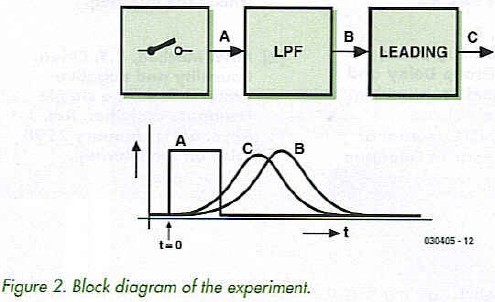

Project Solutions
Project C+ Solved (2)
Published:2011/7/27 3:02:00 Author:Amy From:SeekIC
By Prof. Martin Ohsmann
Causality
Causality states that in our physical world the flow of events is always the same: first, cause, then effect. You are aware of pain in your thumb after you hit it with a hammer and not before the unfortunate accident. If this principle is universal, is it possible in our simple circuit that a signal arrives at the output of a filter before it was applied to the input? Clearly not. To understand what really is going on in the circuit we need to take a closer look. Figure 2 shows a block diagram representing the main parts of the circuit. A rectangular pulse is generated when the switch is momentarily closed at t = 0. A low-pass Filter (LPF) is used next to filter out the high frequency components and produce a smoothed Gaussian impulse at B. The pulse is now introduced to the medium and recovered by the lead filter to produce the output pulse C. The recovered pulse is amplified to produce the output pulse C so that its shape is similar to the input pulse. 
The circuit doubles-up the pulse shaping and lead-filter stages to optimise the effect. Additional components in the Lead Filter help reduce noise in the circuit. The more observant among you will have noticed that the output pulse rises more quickly than the input pulse. It was found to be impractical to increase ’negative group delay’ effect further by adding more lead filters. So there really is nothing unusual about the circuit, the effect is produced using just conventional components. The need for 400 m of cable was also something of a red herring.
The circuit demonstrates that in this case the group velocity is not relevant to the (negative) time difference observed between the input and output pulses, here the front velocity (the propagation speed of an abrupt change or front) of the system is more important.
The effects produced here are still the subject of hot debate on the Internet but in any case you will no doubt be pleased that causality is still intact (at least for the time being) and this experiment underlines how careful you need to be when interpreting test results especially in systems using slow pulses. A similar phenomenon to that shown here occurs with a Mach Zehnder interferometer (no, honest), where light pulses appear to arrive ‘too early’. For more information on this subject refer to 121. If you are still curious about propagation speeds and anomalous dispersion then the classic work by Jackson [3) should fill in any gaps.
Reprinted Url Of This Article: http://www.seekic.com/blog/project_solutions/2011/07/27/Project_C__Solved_(2).html
Print this Page | Comments | Reading(496)
Article Categories
New published articles
· Imagination works with TSMC to develop FinFET process
Author:Ecco Reading(33527)
· XMOS pushes event-driven MCUs with lower price
Author:Ecco Reading(3534)
· Intel brings upgraded 32-nm SoC for smartphones
Author:Ecco Reading(3250)
· Micron pushes TLC 128-Gbit NAND flash
Author:Ecco Reading(3816)
· Intel will stop supplying desktop motherboards
Author:Ecco Reading(5341)
· Processor market was expected to regain strength in 2013
Author:Ecco Reading(3318)
· It was reported that TSMC sales fall steeply
Author:Ecco Reading(3474)
· Cisco, NXP work with auto wireless startup
Author:Ecco Reading(3620)
· Micron was impacted by manufacturing glitch
Author:Ecco Reading(4017)
· China can make 22-nm transistor by themselves
Author:Ecco Reading(3820)
· Chip market rebound is coming, according to survey
Author:Ecco Reading(3761)
· Sony, Toshiba will spend more on chips, iSuppli reports
Author:Ecco Reading(3790)
· Qualcomm becomes the 13th company to join NFC Forum board
Author:Ecco Reading(6105)
· TSMC increases building work for FinFET fab
Author:Ecco Reading(3778)
· TI plans to cut 1,700 jobs in OMAP shift
Author:Ecco Reading(4587)